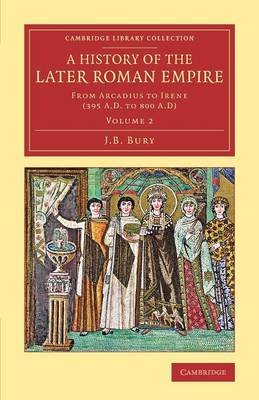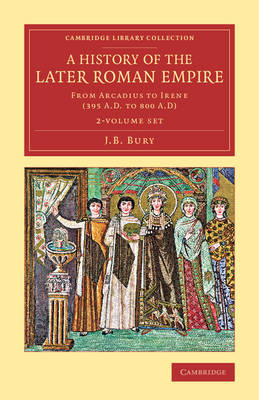Cambridge Library Collection - Classics
1 primary work • 4 total works
Volume 2
The classical historian J. B. Bury (1861-1927) was the author of a history of Greece which was a standard textbook for over a century. He also wrote on later periods, and, in this two-volume work of 1889, examines Byzantine history from 395 to 800. Arguing for the underlying continuity of the Roman empire from the time of Augustus until 1453, Bury nevertheless begins his account in the year in which, on the death of Theodosius I, the empire was divided into eastern and western parts, and Constantinople began to take on the metropolitan role formerly held by Rome. Volume 2, after reviewing Justinian's legacy, takes the history down from the accession of Justin II to the death of Irene in 803. Topics examined include civil strife, including the period of iconoclasm, and the increasing problems of maintaining the imperial borders against incursions from both east and west.
The classical historian J. B. Bury (1861-1927) was the author of a history of Greece which was a standard textbook for over a century. He also wrote on later periods, and, in this two-volume work of 1889, examines Byzantine history from 395 to 800. Arguing for the underlying continuity of the Roman empire from the time of Augustus until 1453, Bury nevertheless begins his account in the year in which, on the death of Theodosius I, the empire was divided into eastern and western parts, and Constantinople began to take on the metropolitan role formerly held by Rome. Broadly chronological, but with an extended section on the state of the empire at the end of the fourth century, Volume 1 covers the period to the deaths of Belisarius and Justinian in 565, and Volume 2, after reviewing Justinian's legacy, takes the history down to the death of Irene in 803.
The classical historian J. B. Bury (1861-1927) was the author of a history of Greece which was a standard textbook for over a century. He also wrote on later periods, and, in this two-volume work of 1889, examines Byzantine history from 395 to 800. Arguing for the underlying continuity of the Roman empire from the time of Augustus until 1453, Bury nevertheless begins his account in the year in which, on the death of Theodosius I, the empire was divided into eastern and western parts, and Constantinople began to take on the metropolitan role formerly held by Rome. Broadly chronological, but with an extended section on the state of the empire at the end of the fourth century, Volume 1 covers the period to the deaths of Belisarius and Justinian in 565, examining the decline of paganism, the inroads of 'barbarians', and the cultural milieu of the early Byzantine empire.
The classical historian J. B. Bury (1861-1927) was the author of a history of Greece which was a standard textbook for over a century. He also wrote on later periods, and, in this two-volume work of 1889, examines Byzantine history from 395 to 800. Arguing for the underlying continuity of the Roman empire from the time of Augustus until 1453, Bury nevertheless begins his account in the year in which, on the death of Theodosius I, the empire was divided into eastern and western parts, and Constantinople began to take on the metropolitan role formerly held by Rome. Volume 2, after reviewing Justinian's legacy, takes the history down from the accession of Justin II to the death of Irene in 803. Topics examined include civil strife, including the period of iconoclasm, and the increasing problems of maintaining the imperial borders against incursions from both east and west.


